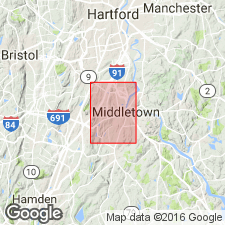
- Usage in publication:
-
- East Berlin formation
- Modifications:
-
- Named
- Dominant lithology:
-
- Shale
- Mudstone
- AAPG geologic province:
-
- Hartford basin
- Pomperaug basin
- New England province
Summary:
The upper sedimentary division of the Meriden formation of Krynine (1950) is here named the East Berlin formation of the Newark group. It consists of fine-grained arkosic shale and mudstone, mostly grayish red, with some grayish black shale. It conformably overlies the Holyoke basalt and conformably underlies the Hampden basalt.
Source: GNU records (USGS DDS-6; Reston GNULEX).
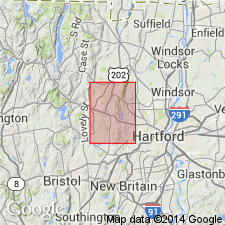
- Usage in publication:
-
- East Berlin formation*
- Modifications:
-
- Overview
- AAPG geologic province:
-
- New England province
- Hartford basin
- Pomperaug basin
Summary:
The East Berlin formation of the Newark group is here accepted for use by the U.S. Geological Survey.
Source: GNU records (USGS DDS-6; Reston GNULEX).
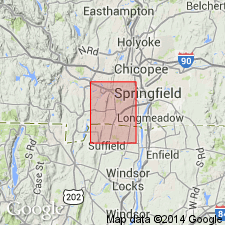
- Usage in publication:
-
- East Berlin Formation*
- Modifications:
-
- Areal extent
- AAPG geologic province:
-
- New England province
- Hartford basin
- Pomperaug basin
Summary:
The East Berlin Formation is here extended to MA where it includes rocks mapped by Emerson (1898) as Longmeadow Sandstone.
Source: GNU records (USGS DDS-6; Reston GNULEX).
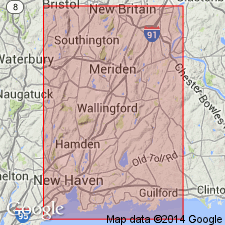
- Usage in publication:
-
- East Berlin Formation
- Modifications:
-
- Revised
- AAPG geologic province:
-
- New England province
- Hartford basin
- Pomperaug basin
Summary:
The East Berlin Formation is here assigned to the Meriden Group in CT. The road cuts along Hwy 72 are designated the type locality. Thickness varies from 1,500 ft (457 m) in southern CT to 600 ft (183 m) in central CT.
Source: GNU records (USGS DDS-6; Reston GNULEX).
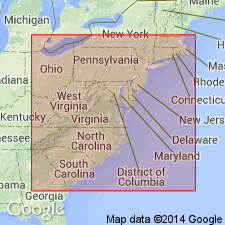
- Usage in publication:
-
- East Berlin Formation
- Modifications:
-
- Biostratigraphic dating
- AAPG geologic province:
-
- New England province
- Hartford basin
- Pomperaug basin
Summary:
The age of the East Berlin Formation is Hettangian based on pollen and spore assemblages in gray mudstone.
Source: GNU records (USGS DDS-6; Reston GNULEX).

- Usage in publication:
-
- East Berlin Formation*
- Modifications:
-
- Overview
- AAPG geologic province:
-
- New England province
- Hartford basin
- Pomperaug basin
Summary:
Used as East Berlin Formation of Early Jurassic age. Consists of reddish-brown to pale-red arkosic sandstone and siltstone, and gray sandstone, gray mudstone, and black shale, all interpreted as lake beds. Unnamed subunit of pale-red conglomerate and arkosic sandstone separately mapped.
Source: GNU records (USGS DDS-6; Reston GNULEX).
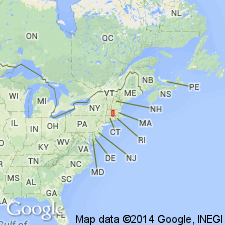
- Usage in publication:
-
- East Berlin Formation*
- Modifications:
-
- Revised
- AAPG geologic province:
-
- New England province
- Hartford basin
- Pomperaug basin
Summary:
Assigned to Newark Supergroup.
Source: GNU records (USGS DDS-6; Reston GNULEX).
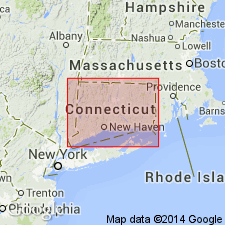
- Usage in publication:
-
- East Berlin Formation*
- Modifications:
-
- Overview
- AAPG geologic province:
-
- New England province
- Hartford basin
- Pomperaug basin
Summary:
East Berlin Formation of the Newark Supergroup is mapped in the Hartford and Pomperaug basins in CT. Age is Early Jurassic.
Source: GNU records (USGS DDS-6; Reston GNULEX).
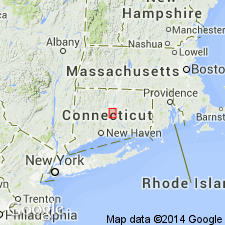
- Usage in publication:
-
- East Berlin Formation
- Modifications:
-
- Overview
- AAPG geologic province:
-
- New England province
- Hartford basin
Summary:
The East Berlin Formation of the Hartford basin contains eight facies: trough cross-bedded sandstones, horizontally stratified sandstones, interbedded sandstones and mudrocks, ripple cross-laminated siltstones, black shales, stratified mudrocks, disrupted shales, and disrupted mudstones. These facies are interpreted as a continental depositional system and are divided into two assemblages. Sandflat/alluvial plain facies assemblage (sandstones and siltstones) is composed of sheet-flood deposits. The lacustrine assemblage (shales and mudrocks) represents a saline lake-playa system.
Source: GNU records (USGS DDS-6; Reston GNULEX).
For more information, please contact Nancy Stamm, Geologic Names Committee Secretary.
Asterisk (*) indicates published by U.S. Geological Survey authors.
"No current usage" (†) implies that a name has been abandoned or has fallen into disuse. Former usage and, if known, replacement name given in parentheses ( ).
Slash (/) indicates name conflicts with nomenclatural guidelines (CSN, 1933; ACSN, 1961, 1970; NACSN, 1983, 2005, 2021). May be explained within brackets ([ ]).

